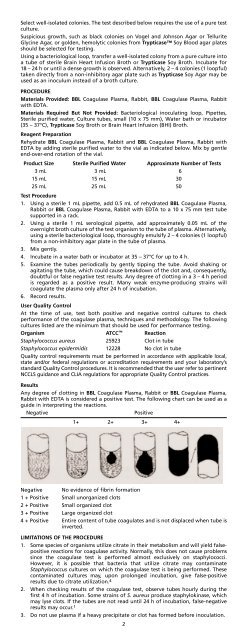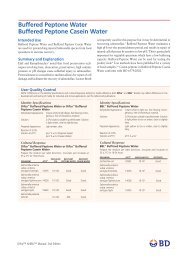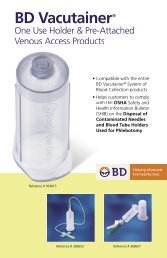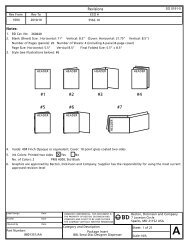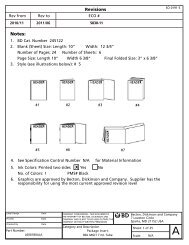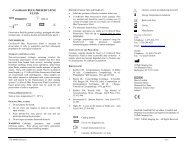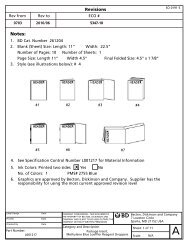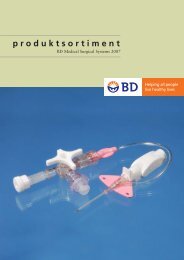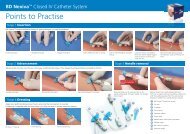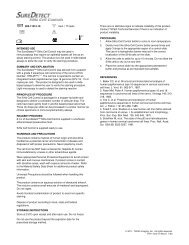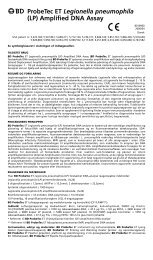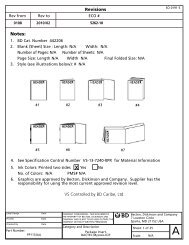BBL Coagulase Plasmas - BD
BBL Coagulase Plasmas - BD
BBL Coagulase Plasmas - BD
Create successful ePaper yourself
Turn your PDF publications into a flip-book with our unique Google optimized e-Paper software.
Select well-isolated colonies. The test described below requires the use of a pure test<br />
culture.<br />
Suspicious growth, such as black colonies on Vogel and Johnson Agar or Tellurite<br />
Glycine Agar, or golden, hemolytic colonies from Trypticase Soy Blood agar plates<br />
should be selected for testing.<br />
Using a bacteriological loop, transfer a well-isolated colony from a pure culture into<br />
a tube of sterile Brain Heart Infusion Broth or Trypticase Soy Broth. Incubate for<br />
18 – 24 h or until a dense growth is observed. Alternatively, 2 – 4 colonies (1 loopful)<br />
taken directly from a non-inhibitory agar plate such as Trypticase Soy Agar may be<br />
used as an inoculum instead of a broth culture.<br />
PROCEDURE<br />
Materials Provided: <strong>BBL</strong> <strong>Coagulase</strong> Plasma, Rabbit, <strong>BBL</strong> <strong>Coagulase</strong> Plasma, Rabbit<br />
with EDTA.<br />
Materials Required But Not Provided: Bacteriological inoculating loop, Pipettes,<br />
Sterile purified water, Culture tubes, small (10 x 75 mm), Water bath or incubator<br />
(35 – 37°C), Trypticase Soy Broth or Brain Heart Infusion (BHI) Broth.<br />
Reagent Preparation<br />
Rehydrate <strong>BBL</strong> <strong>Coagulase</strong> Plasma, Rabbit and <strong>BBL</strong> <strong>Coagulase</strong> Plasma, Rabbit with<br />
EDTA by adding sterile purified water to the vial as indicated below. Mix by gentle<br />
end-over-end rotation of the vial.<br />
Product Size Sterile Purified Water Approximate Number of Tests<br />
3 mL 3 mL 6<br />
15 mL 15 mL 30<br />
25 mL<br />
Test Procedure<br />
25 mL 50<br />
1. Using a sterile 1 mL pipette, add 0.5 mL of rehydrated <strong>BBL</strong> <strong>Coagulase</strong> Plasma,<br />
Rabbit or <strong>BBL</strong> <strong>Coagulase</strong> Plasma, Rabbit with EDTA to a 10 x 75 mm test tube<br />
supported in a rack.<br />
2. Using a sterile 1 mL serological pipette, add approximately 0.05 mL of the<br />
overnight broth culture of the test organism to the tube of plasma. Alternatively,<br />
using a sterile bacteriological loop, thoroughly emulsify 2 – 4 colonies (1 loopful)<br />
from a non-inhibitory agar plate in the tube of plasma.<br />
3. Mix gently.<br />
4. Incubate in a water bath or incubator at 35 – 37°C for up to 4 h.<br />
5. Examine the tubes periodically by gently tipping the tube. Avoid shaking or<br />
agitating the tube, which could cause breakdown of the clot and, consequently,<br />
doubtful or false negative test results. Any degree of clotting in a 3 – 4 h period<br />
is regarded as a positive result. Many weak enzyme-producing strains will<br />
coagulate the plasma only after 24 h of incubation.<br />
6. Record results.<br />
User Quality Control<br />
At the time of use, test both positive and negative control cultures to check<br />
performance of the coagulase plasma, techniques and methodology. The following<br />
cultures listed are the minimum that should be used for performance testing.<br />
Organism ATCC Reaction<br />
Staphylococcus aureus 25923 Clot in tube<br />
Staphylococcus epidermidis 12228 No clot in tube<br />
Quality control requirements must be performed in accordance with applicable local,<br />
state and/or federal regulations or accreditation requirements and your laboratory’s<br />
standard Quality Control procedures. It is recommended that the user refer to pertinent<br />
NCCLS guidance and CLIA regulations for appropriate Quality Control practices.<br />
Results<br />
Any degree of clotting in <strong>BBL</strong> <strong>Coagulase</strong> Plasma, Rabbit or <strong>BBL</strong> <strong>Coagulase</strong> Plasma,<br />
Rabbit with EDTA is considered a positive test. The following chart can be used as a<br />
guide in interpreting the reactions.<br />
Negative Positive<br />
1+ 2+ 3+ 4+<br />
Negative No evidence of fibrin formation<br />
1 + Positive Small unorganized clots<br />
2 + Positive Small organized clot<br />
3 + Positive Large organized clot<br />
4 + Positive Entire content of tube coagulates and is not displaced when tube is<br />
inverted.<br />
LIMITATIONS OF THE PROCEDURE<br />
1. Some species of organisms utilize citrate in their metabolism and will yield falsepositive<br />
reactions for coagulase activity. Normally, this does not cause problems<br />
since the coagulase test is performed almost exclusively on staphylococci.<br />
However, it is possible that bacteria that utilize citrate may contaminate<br />
Staphylococcus cultures on which the coagulase test is being performed. These<br />
contaminated cultures may, upon prolonged incubation, give false-positive<br />
results due to citrate utilization. 4<br />
2. When checking results of the coagulase test, observe tubes hourly during the<br />
first 4 h of incubation. Some strains of S. aureus produce staphylokinase, which<br />
may lyse clots. If the tubes are not read until 24 h of incubation, false-negative<br />
results may occur. 1<br />
3. Do not use plasma if a heavy precipitate or clot has formed before inoculation.<br />
2


